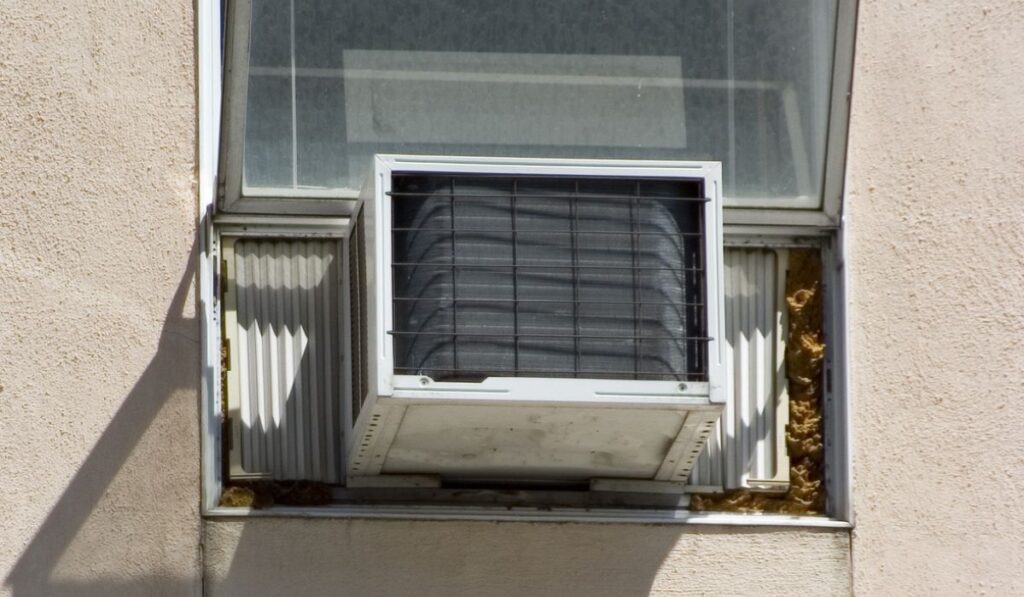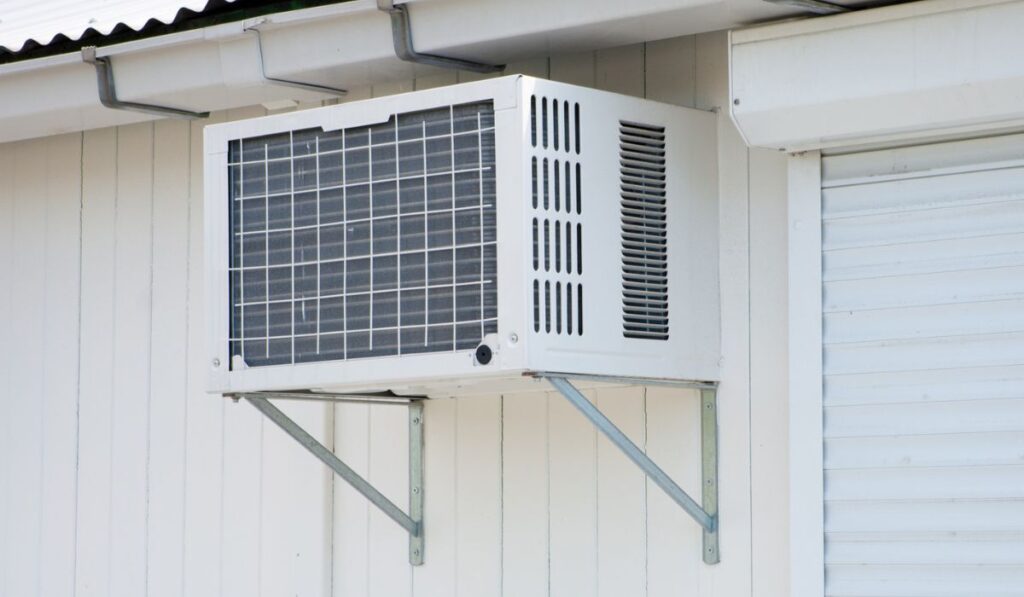It’s no joy wrenching on a car or working on a project in a hot garage. The heat and humidity in a hot garage slow you down, make you cranky, and raise your frustration. However, the good thing is that there are many ways to cool down a hot garage. For instance, you can install a Window AC.
Yes, you may install a window air conditioner in your garage, and if done right, it is safe. Some materials and tools should be stored in cooler temps. If you select to install an air conditioner in your garage, we urge you to make it as energy-efficient as possible.
If you want to make your garage more comfortable or if you don’t want to suffer heat stroke while working there, it’s time to invest in a Window AC unit. Now, let’s find out the appropriate air conditioner unit for your garage and how to place it.
Why Do People Air Condition Their Garage?

Installing air conditioning in your garage makes it more comfortable in the summer; it will, however, also save you money on your home’s air conditioning. In addition, when you chill your garage, it helps to keep the rooms around it colder.
If you have an attic space above your garage that struggles to stay cool in the summer, eliminating the heat from the lower area of the garage will make a significant impact. Other interior rooms may also benefit, and your energy expenditures may be reduced.
The air pocket within your garage can assist in restricting the absorption of outdoor heat into your home in the same way that insulation keeps warm air out. Hot air flows into your home through a shared wall or door from an uncooled garage, raising inside temperatures and pushing your air conditioner to work more.
Can You Put a Window AC Unit in a Garage?
Yes. In most garages, a simple window air conditioner will suffice. Your garage most likely has a window, making this a simple installation. If not, most garages have unfinished walls, creating a through-the-wall structure relatively straightforward. In addition, window air conditioners are inexpensive and efficient.
Be aware that the increased air volume of a garage may necessitate purchasing an AC unit with a larger BTU rating than would be required for a similar-sized room inside the house.
Other Air Conditioners That Would Work In A Garage
Here is the list of other air conditioners that would fit in your garage:
1. Portable Air Conditioners
A portable air conditioner should only be used as a last resort in a room with no other cooling means. They are inefficient and ineffective in comparison to other air conditioners. In addition, a portable device must have a vent to the outside to be effective.
According to HVAC experts, a portable air conditioner can technically be utilized in a garage, but it will perform poorly and leave you unhappy.
2. Ductless “mini-split” Air Conditioners
These air conditioners are similar to the central air conditioner in your home but on a much smaller scale. A significant heat exchanger is located outside the garage, and lines carrying cold fluid that chills the air within a small output unit are run through the wall (or even multiple units).
The cut through the wall can be as small as a few inches, and the output device can be placed wherever it is most beneficial. These units are arguably the most effective and versatile garage conditioning option, but the initial cost is substantially greater than a window unit.
3. Exhaust Fan
If the sun is directly shining on your garage, but the outside air is somewhat comfortable, a strong exhaust fan is the cheapest method to make your garage space bearable. These can be put in a window or through the wall permanently.
The fan will draw hot air out of the garage, allowing cooler air to enter through an open door or a window. This also clears fumes in the garage, like those from a running automobile, or paints, varnishes, or solvents you might be working with.
How To Install An Air Conditioner In A Garage
Here is the step-by-step guide on how to install an air conditioner in your garage:
1. Consider Insulating
You don’t need to install insulation if you only use your garage A/C occasionally. It will simply take longer to get a comfortable temperature, and the A/C compressor will run for more extended periods, resulting in increased utility bills.
You can significantly reduce cool-down time and boost cooling efficacy by hanging drywall on the ceiling. This helps cool air circulate by reducing the size of the cooling region. And install a vapor barrier if you wish to add attic insulation later.
If you plan to use the garage A/C frequently, it’s well worth insulating and completing the entire room.
2. Size the AC Unit
To establish the total square footage of your garage:
- Measure its area and check the chart.
- Use the adjusting factors at the bottom of the chart to make adjustments.
- Look for the most excellent deal on an air conditioner and a through-the-wall sleeve.
3. Choose a Spot and Create an Opening
- Remove the central stud and leave a three gap taller than the A/C sleeve’s rough opening height to accommodate the top and bottom plates.
- Break the cut piece free from the sheathing and siding nails by knocking it sideways.
- Because air conditioners have ineffective circulating fans, they should not be installed on the end wall of an oversized, rectangular garage. Instead, put it in the center of the longest wall, with the airflow directed toward the garage door.
- If your window unit is on the end wall of a rectangular garage, consider installing circulating fans to help disperse the cold air to the other end.
- Look for the approximate opening size in the sleeve installation instructions. A 1-in. is desired by some manufacturers. The sides and top of the sleeve should have clearance since the distance from the ceiling is essential. The opening should not be immediately below the top wall plate, which will result in poor cooling and rapid compressor cycling.
- The top of the sleeve opening is measured 24 inches down from the rafters.
- If there is any drywall in that area, remove it to expose the studs.
- Allow for the new top and sill plates’ thickness by cutting the middle stud. The siding is the most challenging process.
- In most circumstances, it’s advisable to remove as much siding as necessary before cutting the sheathing opening, then trim and re-side the space.
- To attach and secure the sleeve to the framing, follow the manufacturer’s instructions.
- Install the receptacle and run an electrical cable to the spot.
A dedicated box on a 15 or 20-amp circuit breaker is required for most 120-volt equipment (no extension cords allowed). A 20-amp, 120-volt circuit will typically power a unit rated between 9,000 and 12,000 Btu. Larger units, however, will require a 220-volt course.
4. Incorporate Circulation Fans
A through-the-wall air conditioner will direct most of its cool air into the garage’s center, causing scorching areas on the sides. Install a ceiling fan to pull hot air from the corners and blow it down to the floor for more consistent cooling. Use a floor fan to blow the newly warmed floor air up toward the A/C unit inlet opposite side.
Things To Consider Before Putting Air Conditioning In Your Garage

Here are the things why you could but shouldn’t use a garage air conditioner:
1. Proper Ventilation
You’ll need to decide where to vent your air conditioner—an external wall, garage door, or small glass windows are all options. Or maybe you’re one of the lucky ones with a full-sized garage window.
But if you don’t have a suitable location, try installing the vent in an exterior wall, which will almost certainly necessitate cutting a tiny hole in the wall.
Whatever solution you pick, you must vent the air conditioner while it operates because the released hot air must have somewhere to escape. Otherwise, it will pass through the unit and back into your garage, overshadowing your efforts to chill the region.
2. Size of Your Garage
It’s also crucial to get an air conditioner big enough to cool your entire garage. But, first, you’ll need to determine how much space you have and compare it to the unit’s BTU rating. A more excellent BTU rating indicates that the team will be able to remove more hot air from a larger space in less time.
Because most garages have a lot of open space, little to no insulation, and hot temperatures, you must select an air conditioner with a more excellent BTU rating than you think you need. This will allow the air to cool more quickly while putting less load on the unit. It won’t solve all of your garage cooling problems, but it will assist.
3. Consider a Commercial-Sized AC Unit
Despite their higher initial cost, commercial air conditioners are built with durable, heavy-duty, and sturdy materials. These units are developed primarily for warehouses and industries, where an air conditioner is not always practical or cost-effective. However, these units could be the most excellent option for cooling a hot space like a garage.
